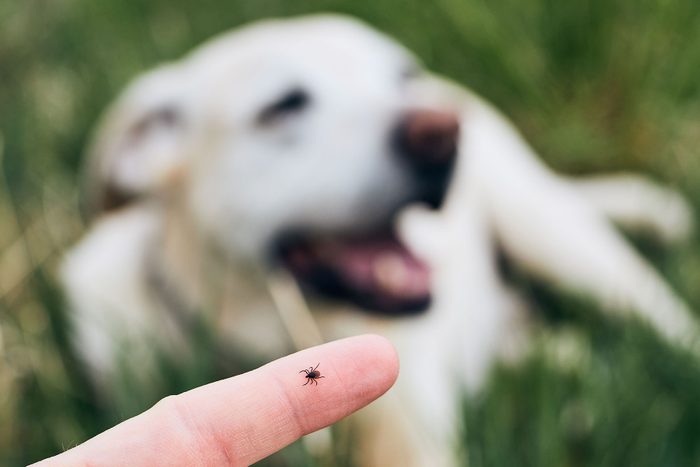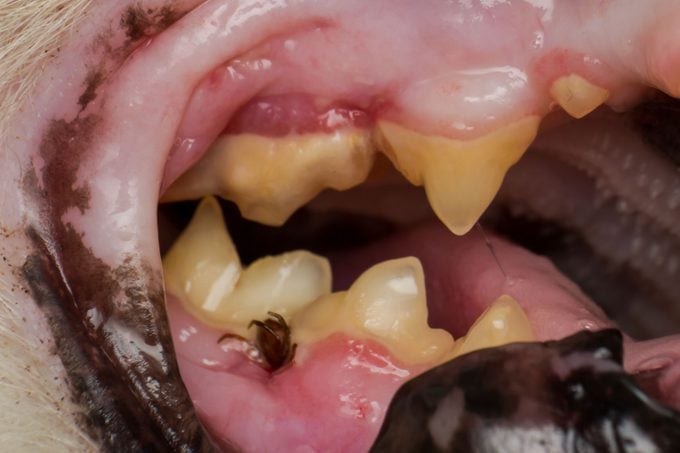Can Dogs Get Ticks in Their Mouths?
Updated: Apr. 17, 2024

You perform routine tick checks on your dog, but you could be neglecting an important area—your dog's mouth. But can dogs get ticks in their mouths?
With spring in high gear and summer on the horizon, it’s time to be vigilant about tick searches after any outdoor excursions. To keep your dog safe this summer and beyond, you should check your pup for pesky ticks that carry diseases.
Ticks are ectoparasites—which means they’re parasites that live outside of a host and can easily climb aboard your dog without Fido noticing. When they bite your dog, they can transmit diseases like canine ehrlichiosis, Lyme disease and canine anaplasmosis—which the American Kennel Club states can pose a serious threat to humans and dogs.
Unfortunately, ticks are commonplace in many U.S. states, and several species affect dogs. Per PetMD, these species are active at different times of the year, so regularly checking your dog for ticks will help keep them safe. People in specific states are at even greater risk, according to the U.S. Centers for Disease Control and Prevention (CDC), so be sure to assess the level of risk in your area. Ticks may appear on your dog’s hindquarters, front legs, torso or ears, to name a few places, but can dogs get ticks in their mouths? Here’s what your regular tick checks should include.
While you’re at it, also explore how to safely remove ticks.
Can Dogs Get Ticks In Their Mouths?

Yep, dogs can get ticks in their mouths, and when they do, ticks may get under your dog’s gums or between their teeth. So when examining your dog’s mouth, leave no spot unturned, including their cheeks, tongue and gums.
According to UK-based pet insurance company Scratch and Patch, you should “check for anything that looks like food caught in the teeth as, in some cases, these dark splotches are well-concealed ticks.”
How Do You Get a Tick Out of a Dog’s Mouth?
The procedure will be much the same as it would be if you found a tick anywhere else on your dog. First, get some tweezers and grasp the tick as close to the skin as possible. Then, give it a gentle pull upward or opposite the direction it burrowed in. Removing the tick quickly is the best course of action to prevent the potential spread of disease.
If your dog is exposed to heavily wooded areas and other environments ticks thrive in, you may want to invest in a tick removal product, such as The Original Tick Key.
Once you’ve removed a tick, monitor your dog for signs of tick-borne disease. According to the CDC, it’s important to watch your dog for any behavioral or appetite changes if you’re suspicious of a tick bite, as “signs of tick-borne disease may not appear for 7-21 days or longer after a tick bite.”
Tips for Tick Prevention in Dogs
You should be aware of your surroundings and perform regular tick checks to prevent ticks from hitchhiking on your pup.
But you can also undertake these preventative measures to keep your dog safe:
- Understand the differences between fleas and ticks and how they affect your dog
- If your backyard or home has a tick infestation, you may want to treat the area with a pesticide. Consult a professional before doing so.
- Talk to your veterinarian about preventative measures, such as tick control treatments.
- Make sure your dog receives an annual test for any tick-borne diseases
- Ask your vet about common tick-borne diseases in your area
- If needed, try to lessen or remove a tick habitat in your yard or property by frequently mowing your lawn and keeping your space clear of leaf litter.
- Check your dog for ticks after every outdoor excursion. It’s tedious, but if you catch a tick on your dog before it bites, you’ve just prevented the potential spread of a tick-borne disease.
As you plan your outdoor activities, remember these prevention tips to keep your dog and your family safe from these dangerous ectoparasites.
